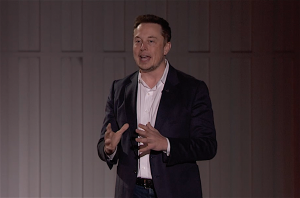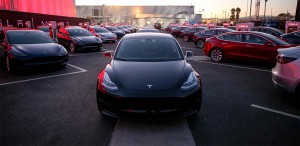
Tesla's Elon Musk told investors the company will be closing in on higher production numbers for the Model 3.
Tesla on Tuesday confirmed that it again fell short of its production target for the much-delayed Model 3 sedan, though it also promised that the “production rate will climb rapidly” from the 2,000 battery-cars assembled each week in late March to 5,000 by the end of the second quarter.
Delays with the ramp-up of the Model 3, Tesla’s first mainstream offering, have been a nightmare for the California-based carmaker, plunging its first-quarter earnings deeply into the red and raising the specter of having to raise new equity to fund its ongoing operations. But after a sharp plunge in its stock over the past month, investors appear to be taking solace in the latest production figures, Tesla shares surging by more than 3% in late morning trading.
Tesla played up the positive in a statement Tuesday, despite missing its production target. It cited “the progress made thus far” as “laying the groundwork” for a strong third quarter. “As a result, Tesla does not require an equity or debt raise this year, apart from standard credit lines.”
In its 8K filing with the U.S. Securities and Exchange Commission, Tesla said it produced 2,020 Model 3 vehicles during the most recent seven-day period, and expects to produce 2,000 more in the coming week – along with a combined 2,000 of its older Models S and X. All told, it assembled 9,766 of the smaller battery-sedans during the first-quarter, “a fourfold increase,” it stated, during the final three-month period in 2017.
But the automaker had been expected to do even better, coming closer to the 2,500 weekly target for the Model 3 it had previously laid out.
And while it now is shooting for “a production rate of approximately 5,000 per week in about three months,” according to a statement accompanying the federal filing, it remains to be seen when it will be able to boost production to a combined 500,000 yearly total – about 80% of them Model 3 sedans – that CEO Elon Musk had promised for 2018.
(Tesla again misses production target for Model 3. Click Here for the story.)
Nonetheless, Musk was typically upbeat about the latest numbers, promising production will soon accelerate so rapidly it may soon “exceed even that of Ford and the Model T.” That was a clear reference to what happened more than 100 years ago when Ford Motor Co. launched its first moving assembly line and explosively increased production of a vehicle generally credited with putting America on wheels.
Tesla clearly needs to boost production fast. During an earnings conference call shortly after the books were closed on the second quarter of 2017, Musk revealed that Tesla had taken 455,000 advanced reservations for the Model 3, each with a minimum $1,000 deposit.
About the same time, the CEO warned that he expected to face “production hell” in the launch of the Model 3, though the troubles proved to be even worse than anticipated. The company subsequently warned that many of those orders would not be delivered until well into 2019. It still remains to be seen how soon Tesla will be able to catch up.
And there have been numerous reports that the order bank has been slipping. Some California-based Chevrolet dealers have stated that they are selling some Chevrolet Bolt EVs to those who have cancelled reservations for the Model 3. The Bolt has been outselling the Tesla sedan in recent months and parent General Motors recently announced it will increase production in the coming months.
(Click Here for details about Tesla shareholders approving multi-billion dollar package for Elon Musk.)
While Tesla will not disclose the size of the current reservation bank, a spokesman noted in a statement, “Net Model 3 reservations remained stable through Q1. The reasons for order cancellation are almost entirely due to delays in production in general and delays in availability of certain planned options, particularly dual motor AWD (all-wheel-drive) and the smaller battery pack.”
Losing even a small number of sales could be problematic, however, as the Model 3 carries a far smaller profit margin than the bigger and far more costly Models S and X, industry analysts have noted.
“The bigger concern is they are sacrificing Models S and X production to fix Model 3,” said analyst Dave Sullivan, of AutoPacific Inc., “which generates a lot less revenue.”
Sullivan said he doesn’t have much confidence in Tesla’s promise of meeting the 5,000-a-week goal for Model 3 by the end of June, “considering it was an all-hands-on-deck effort to fix production during the last quarter.”
(To see more about Tesla recalling half its vehicles, Click Here.)
But for the moment, investors seem to be more upbeat, and that’s good news for Tesla at a time when a series of other setbacks have raised growing concerns about the company’s long-term prospects, driving its share price down by about a third from its 52-week high.

